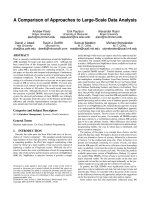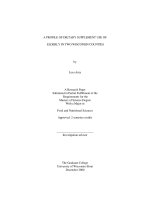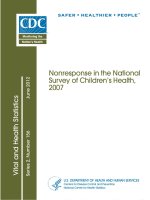A profile of children’s physical activity data from the 2012 and 2015 health survey for england
Bạn đang xem bản rút gọn của tài liệu. Xem và tải ngay bản đầy đủ của tài liệu tại đây (871.85 KB, 7 trang )
(2022) 22:1785
Sims et al. BMC Public Health
/>
Open Access
RESEARCH
A profile of children’s physical activity
data from the 2012 and 2015 health survey
for England
Jamie Sims1,2*, Karen Milton3, Charlie Foster4 and Peter Scarborough1
Abstract
Background: Low childhood physical activity levels constitute an important modifiable risk for adult non-communicable disease incidence and subsequent socio-economic burden, but few publications have explored age and sex
related patterns within the UK population. The aims were to profile child physical activity data from the Health Survey
for England from 2012 (1,732 respondents) and 2015 (5,346 respondents).
Methods: Reported physical activity episodes were converted to metabolic equivalents with reference to childspecific compendiums. Physical activity levels were aggregated for each domain, and again to produce total physical
activity estimates. Contributions from each domain to total physical activity were explored, stratifying for age, sex,
socio-economic deprivation, ethnicity, and weight status. Further analyses were run stratifying for physical activity
levels. Few differences were detected between the survey iterations.
Results: Boys reported higher absolute levels of physical activity at all ages and across all domains. For boys and girls,
informal activity reduces with age. For boys this reduction is largely mitigated by increased formal sport, but this is not
the case for girls. Absolute levels of school activity and active travel remained consistent regardless of total physical
activity, thereby comprising an increasingly important proportion of total physical activity for less active children.
Conclusions: We recommend a specific focus on establishing and maintaining girl’s participation in formal sport
thorough their teenage years, and a recognition and consolidation of the important role played by active travel and
school-based physical activity for the least active children.
Keywords: Physical activity, Health survey for England, Child health, Ethnicity
Background
Physical activity in children has been hypothesised as
being important in reducing the risk of non-communicable diseases across the life-span [1]. Physical inactivity
tends to cluster with overweight and obesity [2], which
itself possesses independent associations with key risk
factors of poor health [3]. Physical inactivity and obesity
*Correspondence:
1
Department of Population Health, University of Oxford, Nuffield, Old Road
Campus, OX3 7LF Oxford, UK
Full list of author information is available at the end of the article
have been shown to track more strongly than physical
activity into adulthood [4, 5], where they constitute independent risk factors for type 2 diabetes [6], cardiovascular disease [7], and cancer [8] incidence and mortality.
These factors combine with indirect consequences that
also arise from childhood inactivity and obesity, including
psychological, social, and economic issues, to compound
negative health impacts such as child self-esteem [9]. The
financial burden associated with the healthcare costs to
service the population is substantial [10], constituting a
clear motivation for governments to promote cost-effective interventions to increase childhood physical activity
© The Author(s) 2022. Open Access This article is licensed under a Creative Commons Attribution 4.0 International License, which
permits use, sharing, adaptation, distribution and reproduction in any medium or format, as long as you give appropriate credit to the
original author(s) and the source, provide a link to the Creative Commons licence, and indicate if changes were made. The images or
other third party material in this article are included in the article’s Creative Commons licence, unless indicated otherwise in a credit line
to the material. If material is not included in the article’s Creative Commons licence and your intended use is not permitted by statutory
regulation or exceeds the permitted use, you will need to obtain permission directly from the copyright holder. To view a copy of this
licence, visit http://creativecommons.org/licenses/by/4.0/. The Creative Commons Public Domain Dedication waiver (http://creativeco
mmons.org/publicdomain/zero/1.0/) applies to the data made available in this article, unless otherwise stated in a credit line to the data.
Sims et al. BMC Public Health
(2022) 22:1785
as part of policy for reducing non-communicable disease
morbidity and mortality in later life [5, 11].
While the case for intervention to increase childhood
physical activity levels is clear, decisions must be supported by adequate data on population trends, facilitating the identification of priority areas for intervention
and programming opportunities for children to participate in physical activity. Since 2005, Physical Activity
Report Cards [12] have been completed regularly for participating nations, reporting on and ‘grading’ the provision of physical activity opportunities for children. A key
element of this report is the quality of surveillance and
evidence from which decision-makers may draw relevant
information, and on which basis which England achieved
a C- in the 2018 report [13].
Within England, the Health Survey for England (HSE)
is used to inform intervention and policy, as it is essential
to have access to regularly updated data on the population-level patterns of physical activity. A specific module
on physical activity has been periodically included within
the survey, including 2004, 2008 and 2012. Respondents
include both adults and children within households in
England, with children’s responses either completed or
verified by a parent. In addition, physical activity was
assessed in a larger ‘boost’ sample of children in 2015.
An analysis of the subset of children meeting physical
activity guidelines from the 2008 survey was completed
by Payne, Townsend [14], concluding that active play was
the largest contributor to total childhood physical activity for both sexes, although this decreased with age to be
partially replaced by formal sport participation. Walking
was the second largest contributor for both sexes, but the
overall contribution from active travel was minimal. Formal sport was more popular among boys than girls at all
age-groups but reduced in popularity as socioeconomic
status declined. However, this analysis was restricted to
‘active’ children and did not include school-based physical activity or physical education, and therefore provides
limited insight into how to target interventions to address
inactivity. There remains a requirement for a comprehensive analysis of childhood physical activity patterns to
inform future interventions or policy given the need to
specifically target those children not achieving healthy
levels of physical activity.
While a domain-level analysis of physical activity
patterns within the English population provides broad
insights, the HSE permits analysis of additional demographic variables hypothesised to moderate physical
activity behaviour. In particular, levels of physical activity have been shown or suggested to vary by sex (e.g.
[15]), age (e.g. [16]), and adiposity (e.g. [17]), as well
as ethnicity and socio-economic deprivation (e.g. [18,
Page 2 of 11
19]), and a more nuanced analysis is therefore possible
in order to inform targeted intervention for those most
in need of support.
The aim of this paper is to identify the contribution
from specific activity-domains to total physical activity
levels in children aged from two to fifteen years, including analyses of differences across key demographic
variables. We investigate variations in physical activity
patterns by age and sex across the full distribution of
child physical activity levels and identify differences in
patterns between 2012 and 2015 survey iterations. We
also investigate domain-specific contribution to total
physical activity levels by level of activity, extending the
work of Payne, Townsend [14] to incorporate the full
spectrum of child activity.
Methods
Sources of data
The HSE is administered via household interview. The
HSE uses a multi-stage stratified probability approach
to provide annual, nationally representative data for a
cross-section of the population of England, conducted
throughout the year to control for seasonality. The
HSE uses the Physical Activity and Sedentary Behaviour Assessment Questionnaire (PASBAQ) to collect
self-reported physical activity behaviour over the seven
days immediately preceding the interview [20]. Children aged above twelve years were interviewed directly,
while for younger children the questionnaire was completed with both a parent and the target child present.
Data on a maximum of two children per household
were collected. The PASBAQ collects the duration and
frequency of participation in specific forms of physical
activity across walking and cycling, domestic activity,
formal sport, and informal activity domains, but does
not include school curriculum time physical activity. A
broad estimation of intensity is also gathered for each
episode of physical activity participation [20, 21]. Episodes of participation in specific periods of at least ten
minutes or more are recorded and summed to provide
domain-specific totals which are then summed to produce a grand total for minutes of physical activity per
week. In the HSE 2015 iteration, a single item requesting an estimate of school-based physical activity in
minutes over the past week was included. This study
used data from the HSE 2012 and 2015, the two most
recent survey iterations to include the physical activity
module. The raw data for both HSE iterations is made
available for download by UCL Data Unit/NHS Digital
and as a result no consent or ethics procedures were
required for this study.
Sims et al. BMC Public Health
(2022) 22:1785
Treatment of data
The raw data were downloaded for all respondents from
the HSE 2012 (n = 10,333) and 2015 (n = 13,748) into
the Stata 15 statistics package [22]. Demographic and
social data were retained for analysis, including age, sex,
identified ethnic group, index of multiple deprivation,
rurality of residence, and BMI status. Index of multiple
deprivation is a composite score of the locality based
on weighted estimates of: income deprivation; employment deprivation; education, skills and training deprivation; health deprivation and disability; crime; barriers to
housing and services; and living environment deprivation
[23]. Scores are typically reported as quintiles within each
survey, meaning that scores cannot be compared directly
between survey years as quintile bands vary.
We excluded all respondents aged above fifteen (8,290
from HSE 2012 & 8,034 from HSE 2015) along with
those under two years of age (311 from HSE 2012 & 278
from HSE 2015). Both surveys incorporated weighting
to address sampling bias due to oversampling of households from sparsely populated areas, dwelling and household unit selection, and non-response calibration. The
HSE 2015 also included a weighting specifically for child
respondents to address potential under-selection from
households with more than two children [24].
For each recorded type of physical activity across all
domains, metabolic equivalence (METs) estimates were
referenced from physical activity equivalence compendiums [25–27]. Estimates of MET minutes per week were
generated by multiplying the number of minutes per
week by the associated MET estimate for each specific
activity. Relevant activity estimates were then summed
to provide an estimate of MET minutes per week for
each domain of physical activity: active travel (walking
or cycling to school); formal physical activity (structured
extra-curricular sport and exercise); informal physical
activity (unstructured activities such as play or skipping);
non-specified physical activity (other forms of physical activity not covered by pre-defined domain-specific
questions); and for the HSE 2015 only, school physical
activity (all activity occurring within the school curriculum including break and lunch times). These domainspecific estimates were then summed to provide a total
amount of weekly exertion through physical activity.
Statistical analysis
For both survey years, total minutes of reported physical activity and mean contributions of physical activity
domains towards total activity were calculated by age and
sex. Descriptive investigation was conducted for total and
domain-specific mean physical activity, stratified by sex,
demographics, and social factors. A series of one-way
Page 3 of 11
ANOVAs were conducted on total and domain-specific
estimates, controlling for age and sex on subsequent variables. For each survey year, total weekly physical exertion was divided into quintiles, providing stratification by
physical activity level to ascertain whether physical activity differs by type as well as by overall quantity at progressive levels of total activity. A series of t-tests were run to
explore differences between 2012 and 2015 data. Survey
weighted estimates were used throughout these analyses.
Results
For the HSE 2012, a sample of 1,732 unique children
were included in the present analysis, of which 50% were
female. Table 1 presents means of total and domainspecific MET mins per week by individual factors for the
HSE 2012. For the HSE 2015, 5,346 unique individuals
were entered into the analysis, of which 49% were female.
Table 2 presents means of total and domain-specific
MET mins per week by individual factors for the HSE
2015. The data are presented in separate tables as, while
the means and standard deviations broadly correspond
across datasets, the inclusion of school physical activity
within HSE 2015 renders the estimates not directly comparable. Comparisons between HSE 2012 and 2015 data
reveal that although occasional differences are observed
between isolated subgroups, no systematic differences
occur between survey iterations.
Effect by sex
For the HSE 2012, boys reported higher total levels of
physical activity than girls (t1732 = 4.86, p < 0.001). There
were only minor differences between boys and girls on
totals for active travel and non-specific physical activity,
with no specific differences emerging when stratified by
age group. Boys accrued a higher percentage of physical activity from formal sports than girls (t1674 = 5.47,
p < 0.001), while girls conversely recruited a higher percentage of physical activity from informal activities
than boys (t1674 = -2.83, p = 0.005), although boys still
reported higher absolute levels of informal physical activity (t1730 = 3.15, p = 0.005). When stratified by age group,
informal activity only differed significantly between sexes
within the 13- to 15-year-old group, but formal activity
showed large differences between sexes in all school-age
groups, with boys consistently achieving more informal
activity and total physical activity than girls.
A similar pattern was observed within the HSE 2015
data, with boys reporting significantly higher physical activity levels than girls on total MET mins per
week including (t5436 = 7.29, p < 0.001) and excluding
(t5436 = 7.19, p < 0.001) school physical activity. These differences between boys and girls largely persisted when
stratified by age. Boys again recruited a higher percentage
Sims et al. BMC Public Health
(2022) 22:1785
Page 4 of 11
Table 1 2012 total and domain-specific MET minutes/week, and percentage contributions, by sex, age, weight status
Category
Total
Active Travel
Mean (SD)
Mean (SD)
%
Mean (SD)
%
Mean (SD)
%
Mean (SD)
%
1732
3326.3 (3054.4)
183.2 (275.4)
5.5
112.5 (494.3)
3.4
470.4 (934.7)
14.1
2560.3 (2840.0)
79.7
Male
862
3682.6 (3297.6)
189.0 (288.5)
5.4
106.1 (430.0)
3.1
611.6 (1086.9)
18.8
2775.8 (2571.9)
72.7
Female
870
2973.4 (2749.5)
177.5 (261.8)
6.0
118.8 (550.9)
4.0
330.4 (728.4)
11.9
2346.8 (2173.8)
78.1
t = 4.86 **
t = 0.87
Cohort
n
Non-Specific
Formal
Informal
Sex
Effect by Sex
t = -0.53
t = 6.33 **
t = 3.15 **
Age Group
2–4
428
3636.0 (3725.2)
93.2 (160.7)
2.6
16.0
(97.8)
0.4
200.6 (616.4)
5.5
3326.2 (3643.4)
91.5
5–7
376
3139.2 (2511.6)
160.7 (183.1)
5.1
78.0 (292.8)
2.5
372.3 (586.0)
11.9
2528.3 (2497.8)
80.5
8–10
368
3355.8 (2717.5)
169.4 (210.0)
5.0
136.5 (387.4)
4.1
606.0 (1009.2)
18.1
2444.0 (2481.2)
72.8
11–12
260
3561.9 (3205.3)
289.2 (385.5)
8.1
206.1 (815.0)
5.8
710.7 (1190.9)
20.0
2355.9 (2676.7)
66.1
13–15
300
2878.6 (3054.4)
264.9 (385.1)
9.2
182.8 (711.2)
6.4
603.5 (1183.4)
21.0
1827.4 (2308.6)
63.5
F = 4.42 **
F = 28.58 **
Effect by Age
F = 8.23 **
F = 18.34 **
F = 14.92 **
Weight Status
Normal
947
3254.1 (2961.2)
186.7 (274.0)
5.7
127.5 (503.7)
3.9
500.9 (963.2)
15.4
2439.0 (2742.6)
75.0
Overweight
190
3566.9 (3345.6)
213.7 (311.7)
6.0
174.0 (812.4)
4.9
534.6 (1080.9)
15.0
2644.5 (3017.5)
74.1
Obese
184
3452.3 (3074.7)
195.4 (287.0)
5.7
64.7 (215.3)
1.9
603.9 (1130.1)
17.5
2588.3 (2667.2)
75.0
F = 0.85
F = 0.53
Effect by Weight Status
*
F = 3.55 *
F = 0.18
F = 0.87
p < 0.05
**
p < 0.01
of total physical activity than girls from formal activity
(t5122 = 10.30, p < 0.001). The remaining domains of active
travel, non-specific, informal, and school physical activity
showed little variation by sex.
Effect by age
Within the HSE 2012, age predicted outcomes on total
MET minutes per week, and on all domain specific physical activity, controlling for sex. Overall, age was positively
correlated with active travel, non-specific, and formal
physical activity, but negatively with total and informal
physical activity. Domain-specific contributions from
each domain to total MET minutes per week are presented in Fig. 1. Further analyses were run stratifying
for sex, finding age a significant predictor of all domainspecific outcomes. However, while age was a predictor of
total MET minutes per week for girls (F4 = 6.42, p < 0.001)
it was not for boys (F4 = 1.19, p = 0.312).
For the HSE 2015 data, age again predicted outcomes
on total MET minutes per week, both including and
excluding school physical activity, and predicted all
domains of physical activity. Age was once more positively correlated with totals for active travel, non-specific
physical activity, formal activity, and for school-based
activity, and was negatively correlated with informal
activity and total MET minutes per week both including and excluding the contribution from school time.
Domain-specific contribution to total MET minutes
per week is presented in Fig. 2. Age remained a predictor for all domains when stratifying by sex; however,
and while total activity differed significantly by age for
girls (F4 = 17.48, p < 0.001), this was not the case for boys
(F4 = 1.47, p = 0.208).
The HSE 2015 incorporated a measure of physical
activity within curriculum time, the first time this had
been included in any HSE iteration. The relative contributions of school activity are shown in Fig. 2, stratified by
age and sex. There were significant differences in school
physical activity levels for both sexes, with age predicting
differences in school-based MET minutes per week for
both boys (F4 = 106.54, p < 0.001) and girls (F4 = 101.30,
p < 0.001).
Effect by weight status
For the HSE 2012 data, weight status did not predict
either total MET minutes per week (F2,7 = 0.85, p = 0.428)
nor any domain-specific total, nor did any significant
effects emerge when stratifying by sex. On the HSE 2015,
weight status significantly predicted total MET minutes per week both including (F2,7 = 6.04, p = 0.002) and
excluding (F2,7 = 6.10, p = 0.002) school activity, which
persisted for girls (F = 4.20, p = 0.015), but not boys
(F2,6 = 2.19, p = 0.112), when stratifying by sex. Increasing weight status also predicted reductions in informal
5436
Cohort
4131.1 (3616.3)
2880.8 (3124.7)
989
639
Obese
3665.2† (3447.8)
F = 6.04 **
3219.9 (3188.8)
3505.2 (3192.7)
156.7† (255.3)
F = 0.85
184.7 (271.0)
167.7† (260.0)
157.9† (260.9)
F = 104.44 **
268.7 (382.3)
252.3 (353.9)
125.3† (186.8)
125.0† (184.4)
88.7 (154.6)
t = -0.85
162.8 (271.5)
p < 0.01, † Significant difference (p < 0.05) between 2012 and 2015 data
p < 0.05
**
*
Effect by Weight Status
3148
644
Normal
Overweight
Weight Status
Effect by Age
F = 16.01 **
3848.8 (3591.3)
3470.4 (3166.9)
1171
730
8–10
11–12
13–15
3531.1 (3119.3)
1281
1265
2–4
3926.5 (3785.1)
t = 7.29 **
3457.8 (3338.8)
160.0 (263.5)
Mean (SD)
Mean (SD)
3792.0 (3418.8)
Active Travel
Total
5–7
Age Group
Effect by Sex
2698
2738
Male
Female
Sex
n
Category
5.7
4.8
4.3
9.3
7.2
3.3
3.5
2.3
4.7
3.8
4.2
%
F = 0.61
77.8
(378.2)
68.6† (290.8)
86.8† (378.7)
F = 15.22 **
111.4 (517.8)
102.0† (393.2)
103.5 (361.7)
56.1 (231.0)
26.2 (175.5)
t = -0.13
76.1† (329.8)
74.9† (358.3)
75.5 (344.2)
Mean (SD)
Non-Specific
2.4
2.0
2.4
3.9
2.9
2.7
1.6
0.7
2.2
1.8
2.0
%
F = 2.53
563.7 (1269.7)
577.7 (1031.1)
563.8 (1300.8)
F = 53.04 **
728.3 (1386.1)
799.2 (1491.9)
690.2 (1478.9)
421.9 (1034.4)
206.4 (552.9)
t = 9.84 **
375.2 (1039.5)
697.9 (1360.9)
535.4 (1220.3)
Mean (SD)
Formal
17.5
16.5
15.4
25.3
23.0
17.9
11.9
5.3
10.9
16.9
14.1
%
Table 2 2015 total and domain-specific MET minutes/week, and percentage contributions, by sex, age, and weight status
Informal
F = 4.82 **
2393.7 (2713.2)
2691.2† (3025.7)
2856.6 (3099.0)
F = 55.36 **
1772.4 (2430.9)
2316.9 (2596.8)
2929.7† (3091.7)
2927.8† (2875.0)
3605.1 (3712.9)
t = 4.15 **
2623.1 (2511.7)
2970.7 (3208.7)
2795.6 (3096.6)
Mean (SD)
74.3
76.8
77.9
61.5
66.8
76.1
82.9
91.8
75.9
71.9
73.7
%
School
F = 0.55
210.3 (374.6)
177.5 (296.6)
182.2 (314.8)
F = 206.47 **
266.3 (415.9)
274.4 (392.8)
197.4 (282.2)
164.7 (239.7)
22.4 (135.6)
t = 1.10
220.7 (330.8)
230.8 (343.4)
225.7 (337.1)
Mean (SD)
6.5
5.1
5.0
9.2
7.9
5.1
4.7
0.6
6.4
5.6
6.0
%
Sims et al. BMC Public Health
(2022) 22:1785
Page 5 of 11
Sims et al. BMC Public Health
(2022) 22:1785
Page 6 of 11
Fig. 1 Relative domain-specific contributions towards mean MET mins/week from HSE 2012, by age and sex
Fig. 2 Relative domain-specific contributions towards mean MET mins/week from HSE 2015, by age and sex
activity (F2,6 = 4.82, p =
0.008). When stratifying by
sex, girls (F = 5.37, p = 0.005), but not boys (F2,6 = 0.91,
p = 0.402), retained a significant effect for informal activity, with no specific effect by gender on formal activity.
Effect by deprivation
Within the HSE 2012, total MET minutes per week did
not differ by QIMD for boys or girls. Neither were there
significant effects for QIMD across domain-specific totals
except for formal physical activity, which differed significantly (F4,9 = 3.98, p < 0.001), an effect which persisted
when stratified by sex for girls (F4,8 = 4.78, p < 0.001), but
not boys (F4,8 = 1.24, p = 0.292).
For HSE 2015, total MET minutes per week varied by
QIMD category when including (F4,9 = 2.38, p = 0.049) or
excluding (F4,9 = 2.55, p = 0.037) school activity, although
neither effect persisted when stratifying for sex. Increasing QIMD was negatively associated non-specific, formal,
Sims et al. BMC Public Health
(2022) 22:1785
and school activity levels, but positively associated with
levels of informal activity. Stratification by sex revealed
differences persisted on all domains of activity, except for
active travel and school-based activity.
Effect by ethnicity
Within the HSE 2012, participants from different identified ethnicities showed a significant variation on total
MET minutes per week (F4,9 = 6.02, p < 0.001) when controlling for age and sex. At domain level, there were no
large differences on active travel or non-specific activity levels but there were effects on formal (F4,9 = 5.83,
p < 0.001) and informal (F4,9 = 4.54, p = 0.001) activity.
For the HSE 2015, different identified ethnicities
showed a significant variation on total MET minutes per
week both when including (F4,9 = 28.97, p < 0.001) and
excluding (F4,9 = 28.12, p < 0.001) school activity, when
controlling for age and sex. There were significant effects
for all domain-specific totals, which persisted when
stratified by sex except for boy’s active travel (F4,8 = 0.79,
p = 0.533) and school activity (F4,8 = 0.59, p = 0.667).
Stratified analysis by levels of physical activity
In addition to the above analyses of the whole survey
sample, it is possible to stratify the responses according
to levels of physical activity to provide a more nuanced
description of the data and extending the work of Payne,
Townsend [14]. Stratifying the HSE 2012 cohort by levels
of physical activity reveals the relative contributions from
each domain of physical activity to total MET minutes
Page 7 of 11
per week for activity-based quintiles of the population.
For the HSE 2015 data, all domain-specific contributions
showed significant regression effects by physical activity
quintile when controlling for age and sex, effects which
persisted when stratifying by sex. There were no statistically significant differences between survey years on
comparable domains, although considerable variation
appears when represented graphically. The percentage
contributions across both HSE 2012 and HSE 2015 from
comparable domains are presented in Fig. 3, with further
data specifically including school activity from HSE 2015
presented in Fig. 4.
Discussion
Analysis of both surveys revealed that boys engage in
higher levels of physical activity than girls, both in terms
of time spent in activity and in relative energy expenditure expressed in MET minutes per week, broadly matching the majority of findings from tracking studies [4, 5,
16, 28, 29]. Boys reported significantly larger absolute
counts of MET minutes per week on the majority of
domains of activity, with the exception of active travel. In
terms of the relative contribution from specific domains,
the most marked difference between sexes was participation in formal sport, where boys participate in a significantly higher amount of physical activity than girls
throughout childhood. This difference was previously
reported by Payne, Townsend [14] although their analysis was limited to data for the most active children; this
more recent and more comprehensive analysis confirms
Fig. 3 Relative contribution from domain-specific activity to total MET mins/week for HSE 2012 and HSE 2015, by activity strata









